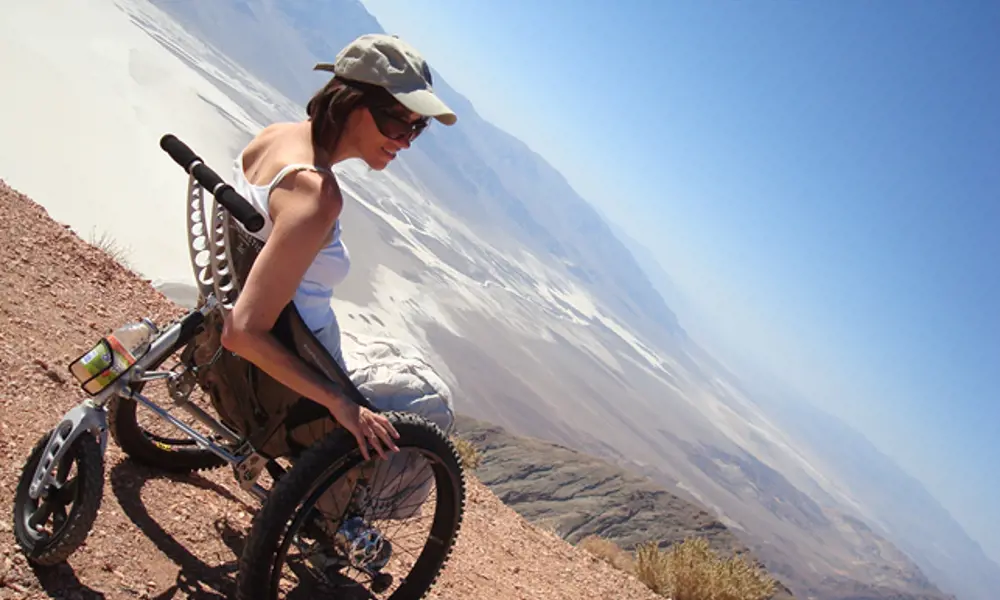
Wheelchairs that access all areas
Twenty years ago, Mike Spindle’s press toolmaking company was producing prototype components and precision tooling for Formula 1 teams at the cutting edge of their sport. He was running a business that was extremely busy from Friday to Sunday during the racing season and was looking for other work to occupy his workforce and high-quality CNC (computer numerical control) machining centre. While in an airport waiting lounge, Spindle saw a wheelchair that would transform his business and test his creative abilities to their limit.
The wheelchair was a standard one that had been sprayed metallic purple to make it stand out from the crowd and its owner was a young, stylishly dressed man. What Spindle saw was a disconnect between the man and his vehicle, modern versus old school. He says: “I thought, is that it? Is that the best they can do to update the chair, spray it purple!”
When looking at the wheelchair, Spindle saw a chair on a metal chassis, similar to a vintage car. He thought that a monocoque chassis, which is integral with the body of the structure as used in motorsport and most modern cars, would provide better stiffness and weight advantage. He also looked at the wheels and thought that having big wheels at the front rather than the back would expend less energy.
With these initial thoughts he started sketching designs on his holiday flight. His mission was to create a modern, more capable wheelchair that would be super-light and accommodate people with a range of disabilities, weights and ages. He wanted the chair to be suitable for both outdoor and indoor use and that any adaptations could be done by the owner without the need for tools or expertise. He set himself the extra challenge of designing the new chair himself without looking at how other wheelchairs, manual or powered, were made or had been developed.
The journey to reinvent the wheelchair was not straightforward. There were setbacks and complicated engineering hurdles that Spindle needed to overcome. Eventually, six years, 14 prototypes and with two worldwide patents in the application stage (later granted), in 2006, he launched a wheelchair that is tailored to each customer’s personal needs using a standardised list of modular options. It is light years away from conventional wheelchairs and his company, Trekinetic, has won many awards for the chair design. It arguably creates the lightest powered wheelchairs on the market with the added bonus that all its chairs can be easily disassembled and fit into a standard, unadapted car.
Varicam
🦽 The innovation that enabled users to reangle their wheelchair’s wheel
The aim of the Varicam innovation was to allow owners to splay the wheels of their chair via right-hand and left-hand screw threads situated under the seat and for it to lock at either end of its travel. There are four pivot points in the system that form a trapezium. At the top, there are two anchoring brackets attaching the seat to the two wheel hubs. At the bottom, the two pivot points are where brackets attach to the shaft, within which are a pair of hardened, steel-top locking screws that limit the movement of the trapezium at each extreme.
Without restraint, the trapezium would swing freely so Spindle created a curved cam that is rotated by adjusting the screw thread. The key design innovation was in shaping the cam so that it would allow enough travel when the adjusting screw thread was turned by hand, but also shaped to engage fully with the locking screws at each end of its travel.
When the adjusting screw is turned one way, the wheels are pulled upright to a wheelbase of 71 centimetres and form a 90° angle within the trapezium, the cam hits the outer locking screws (see diagram) and a rigid self-locking framework is achieved. This is the indoor setting that allows the wheelchair to be narrow enough to pass through door frames.
Fifteen seconds of turning the screw thread in the opposite direction will make the cam hit the inner locking screws, thus activating the friction lock again. This will lengthen the distance between the wheels to their 86 centimetre maximum – the outdoor setting. Eureka was so intrigued by this invention that it was featured as one of the magazine’s famous ‘Coffee Time Challenges’ for readers.
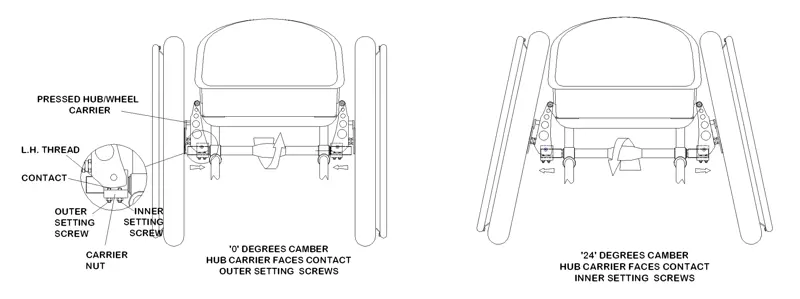
Diagrams show the mechanism that enables users to reangle their wheelchair’s wheel © Trekinetic
Standard Wheelchairs
Wheelchair design has improved only incrementally since the 1930s. Sporting wheelchairs have advanced somewhat but the vast majority of the UK’s 1.2 million wheelchair users are sitting in chairs that were originated by US engineers 80 years ago. Everest & Jennings was the first company to mass-produce wheelchairs. One of its founders, Herbert Everest, had been injured in a mining accident and resented the bulky, rigid wheelchairs that were difficult to push. His friend, Harry Jennings, came up with a tubular-framed, lightweight, pliable chair with an X-frame in the middle that could fold and be placed in a car. Decades later came the innovation that allowed wheels to be removed by simply pressing a quick release pin – called a pip pin. The result is, pretty much, the model that we see today.
The four-wheel design, with two large ones at the back and two castors at the front, works well for most users but does have its limitations. It is ‘tippy’, meaning that the chair tilts backwards quite easily. The two small wheels at the front are impractical on gravel, beaches, or snow: they easily twist out of line, are pushed aside by small obstacles and sink into soft ground. Lastly, pushing the back wheels is inefficient and the movement of pushing downward causes users to lift out of the chair and also dip their heads down.
Spindle decided to bring the large wheels to the front so that the head remains upright and the arms are pushing forwards. This increases the push efficiency by around 30% and generates more power because the user is pushed against the back of the chair, instead of up in the air – for example, weightlifters can press much more weight on their back than they can standing straight without support. Having wheels at the front also means that the wheelchair can go through most soft ground and over obstacles. It can transform lives by enabling people to go across difficult terrain, such as countryside or a beach, without needing someone to push or drag them out of trouble.
Spindle saw an added advantage in being able to vary the wheels’ angle (camber) and splaying them out. By letting out the two 60-centimetre-tall wheels by eight degrees, he could extend the distance between them. The negative camber improves grip when going around corners by transmitting forces through the negative plane of the tyre, while a wider wheelbase helps the wheelchair counter the risk of tipping over at speed. There were a dozen different engineering solutions available to vary the camber, but finding one that involved no tools, that non-technical users or carers could operate, and that could lock the wheels in their various extensions in a way that was quick and failsafe, required ingenuity. It also generated the wheelchair’s first patent [see Varicam].
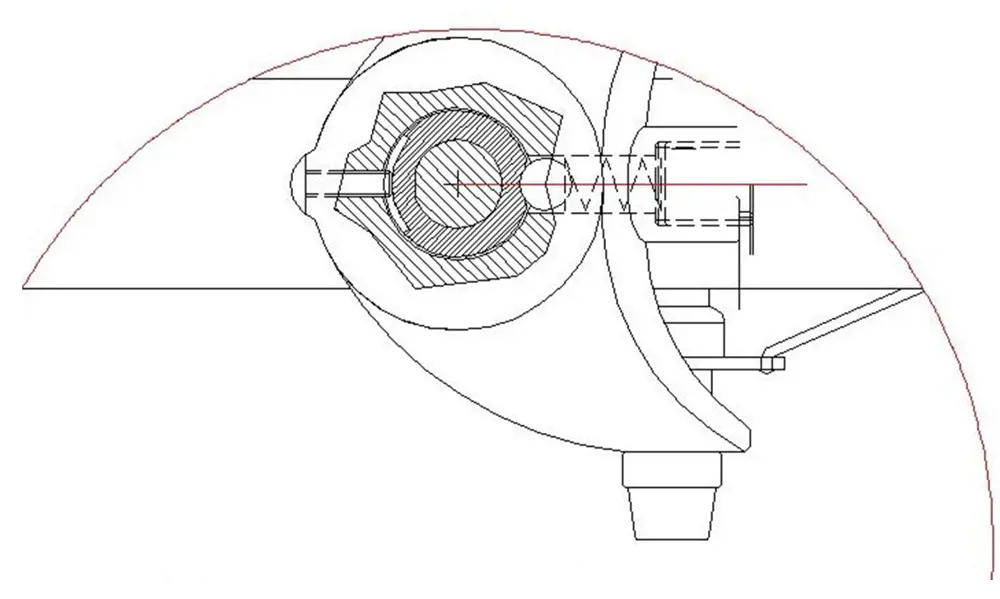
When going forward, a ballbearing sits in a detent (a catch that prevents motion until released), which locks the wheel into a straight position. When enough lateral force is applied, the wheel can twist away from that detent position and steer. The twisting force necessary will be different for each person so an especially designed adjustable spring was made and the detent shaped to control the way the ball moves away from its locked position © Trekinetic
Being different
Perhaps the most striking difference when looking at the Trekinetic wheelchair and what existed before is the monocoque (integrated) set-up. The chair is built around a carbon fibre seat that is moulded to the shape of the user so that the right-angle shape of a standard chair becomes curved, changing the pressure-loading and making it more comfortable. All the other main components are attached to this bucket seat via moulding during fittings.
The fact that the rear wheel is a small castor is another obvious difference, and at the early design stage this caused Mike Spindle one of his biggest headaches as the single castor at the back gave poor directional stability. At the front of a standard chair, two small castors run parallel to each other to maintain the trajectory set by the big rear wheels. However, at the back of a three-wheel set-up the castor is hypersensitive to direction change and would rather spin than go straight – rather like a rogue supermarket trolley wheel that fishtails uncontrollably.
This problem set Spindle back around a year as he tried out various remedies. He wanted to maintain the three-wheel concept as it afforded a smaller turning circle and ensured that all wheels have contact with the ground at any one time. The deceptively simple solution is, in effect, a spring-loaded ball within a cam [see diagram].
Spindle had fashioned a way of effecting a gentle disengagement from the locked position into the rotating one. This innovation is not as vital for the powered version of the chair as the joystick will override this problem, but is crucial for the manual version.
Producing a monocoque wheelchair
🏎️ Creating the 3D design by going back to Formula 1 roots
Most wheelchairs are four-wheel, metal-chassis-based designs made from standard wheelchair parts that are inexpensively produced at a large scale and used by most wheelchair manufacturers.
Almost none of these parts are designed for a monocoque wheelchair configuration. Therefore, the cost of moulds and bespoke parts and an unknown return on investment was a risk few companies were willing to take. Furthermore, the technology simply did not exist.
Spindle was aware that most modes of transport, such as cars, aeroplanes and boats, had already moved away from framework chassis configurations decades before and he was keen to update the wheelchair design. Monocoque is a popular choice with engineers as making one (normally the largest) component strong enough to carry all the other means that they can remove the entire weight and cost of the existing chassis.
Spindle designed a dual-carbon fibre skin that had all the strengthening features on the outside but a smooth inside, making the seat strong, comfortable, light and durable. Additionally, its fixings are precision moulded, which saves more weight and speeds up production.
The CAD-based design took many months, using thousands of pre-plotted data points. Spindle refers to it as “the world’s worst 3D join-the-dots puzzle”. The design was assisted by UK company Computool, which digitally massaged the final curves into place to perfect the original forms.
A significant issue was that it was impossible to know whether all the surfaces were smooth until the actual seat was manufactured. Fortunately, Computool’s programme created a 3D model where surfaces could be rendered with a mirror finish that easily showed any lumps and bumps.
A significant benefit is that the seat is already internally moulded to a shape that mirrors the average human body. This means that minimal cushioning is needed to achieve comfort, although a range of dedicated pressure cushions is also available for more demanding medical applications. Spindle says that most users confirm the Trekinetic seat to be the most comfortable they have ever experienced. He adds: “This goes directly back to our Formula 1 roots. In a racing car, you mould the seat to the driver’s body, so almost no cushioning is required. That is exactly what we have done here, but for a much wider audience.”
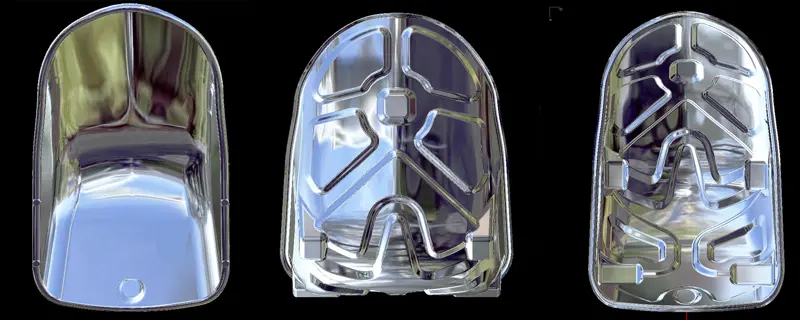
Last pieces of the jigsaw
One of the last major problems that Spindle had to solve during the prototype stage was regulating the chair user’s weight distribution for slopes. Some people will have their seated bodyweight much nearer the front while those who are perhaps missing a leg will have more weight towards the back. During test runs down steep slopes, Spindle found that the wheelchair user risked falling out of a fixed position chair.
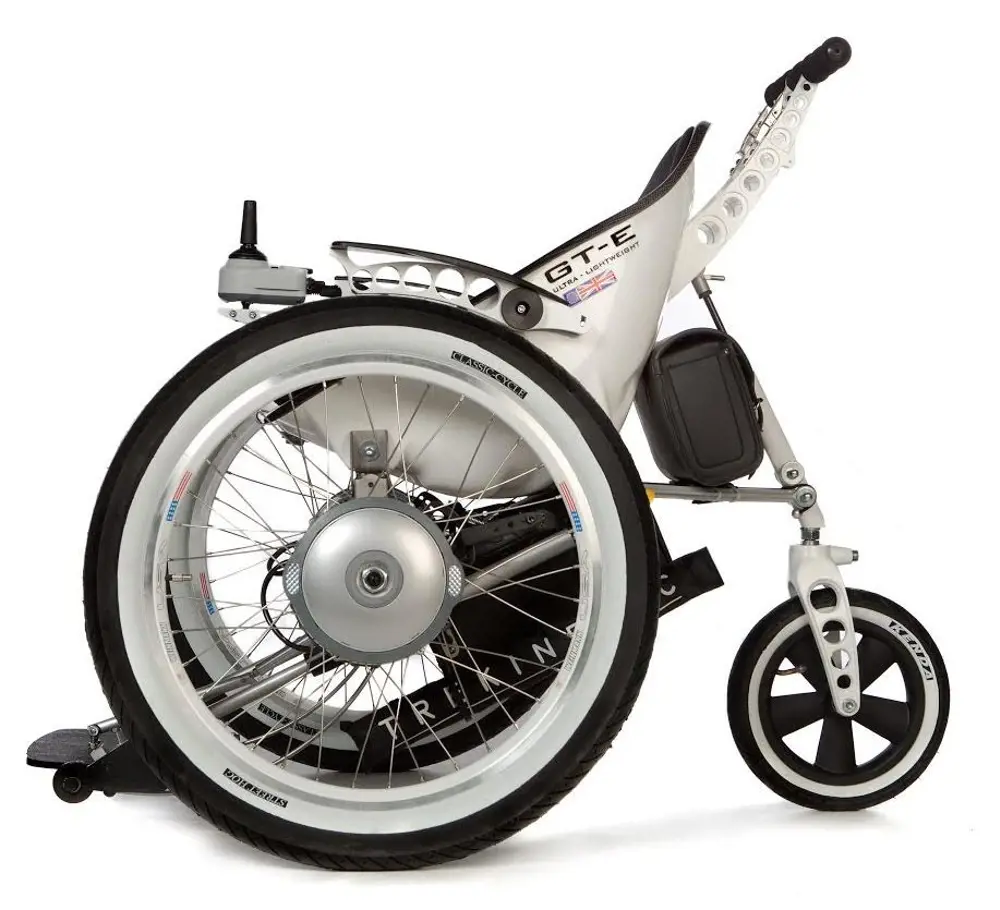
Trekinetic’s powered GTE wheelchair, which has just three components and can easily be folded to fit in the boot of most medium-sized cars © Trekinetic
The solution came when Spindle sat and lowered the positioning of his own office chair. When he lifted the lever of his gas-strut-supported chair, he activated the piston mechanism that expanded the nitrogen gas inside the chamber, which allowed him to alter its height. He contacted the specialist company Stabilus, which provided the gas unit, and then worked on incorporating an adjustable gas strut that would sit on top of the rear castor and support the seat at different adjustable and lockable angles when required.
As the Trekinetic chair has a short wheelbase the strut does not have to move much to enact a significant change in the centre of gravity; such as moving a load on a see-saw, the difference is magnified two-fold. The elegant mechanism that he invented enabled an adjustable but lockable system that could be operated by a non-engineer without an Allen key and secured Spindle another worldwide patent. It has the added benefit of acting as a shock absorber, which is helpful for wheelchair users with back or neuropathic pain.
Before launching the ’all-terrain’ K2, the manual version of the Trekinetic wheelchair, Spindle added drum brakes. These had been used previously on some standard chairs as parking brakes but now a two-way lever system was added that meant they could be used on the move.
The powered GTE
⛰️ Pushing design boundaries to go anywhere
Mike Spindle likens traditional powered wheelchairs to ‘dentists’ chairs on wheels’. Usually made of mild steel, some have two car batteries in them and weigh between 70 and 150 kilograms. Launched in 2014, Trekinetic’s five-speed GTE weighs 35 kilograms and has all the features of the K2 manual chair complete with additional hub motors, power pack, battery control unit and a joystick.
When Spindle had worked on the manual chair there had not been compact enough motors nor small enough batteries to produce a lightweight powered chair. A decade later, he saw that Yamaha had the sort of motor he could assimilate into the Trekinetic design. By placing the hub motors into the wheels, he could spread the chair’s weight. The GTE has three fitted components – the two wheels and monocoque seat – which each weigh just over 10 kilograms, and can be easily placed into the boot of most medium-sized cars.
Trekinetic continues to push boundaries and a lot of its powered chairs have an add-on that makes it even more flexible. Spindle has sourced a body-formable vacuum seat liner that allows increased comfort for customers with conditions such a scoliosis. This innovation also allows young people to keep the same chair while growing into an adult. As a person’s physical condition and posture changes, the owner can also simply pump up the bag into a different shape. This can save thousands of pounds compared to the traditional CNC-machined or moulded prescription seats that cannot be realistically altered.
Because each wheelchair is bespoke the purchase cost is high compared to standard chairs, at around £4,000 for a manual and £10,000 for a powered one. Families often fundraise to obtain one while saving money by not having to buy a special adapted car or van to fit the wheelchairs in.
This year, Trekinetic will sell its thousandth wheelchair and its main publicity is word of mouth. All owners get stopped in the street by people struck by the futuristic design. The Science Museum has further helped raise the profile by having several K2s for visitor hire and main characters in both the 2016 film Assassin’s Creed and the 2017 sci-fi film MindGamers used the chair.
Spindle says that he believes all wheelchair manufacturers will eventually adopt the monocoque template, as pioneered by Trekinetic. He is interested in pushing the new technology further and allowing the company to reach its full potential in mainstream markets. For him the most important element, apart from the kick of seeing new sales and new customers, is job satisfaction. He says: “When we were toolmakers and handed over to a car manufacturer an intricately designed fixture, gauge or tool that I had sweated blood and tears over, I often got in return a shrug and ‘okay, thanks’. It was so frustrating. Whereas now, I can see the look on someone’s face as they see how easy it is to push this chair, go anywhere and make things happen, sometimes for the first time in their lives!”
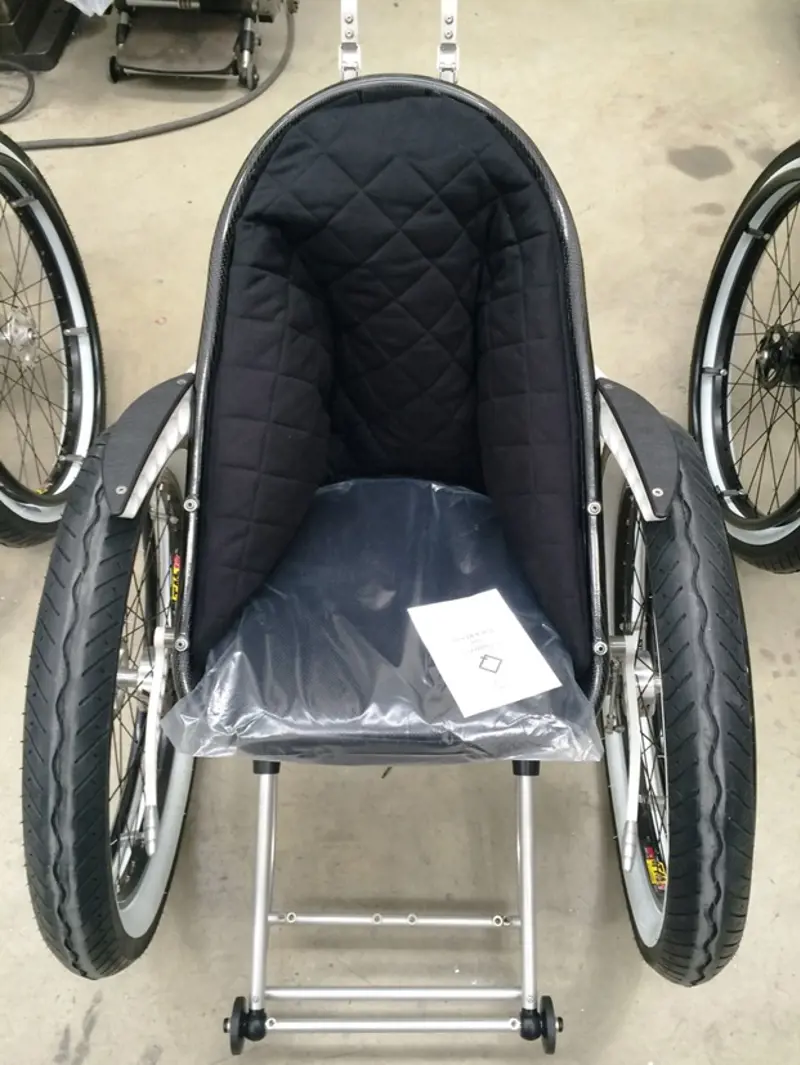
The Hyperforma seat insert was originally invented by an occupational therapist and is filled with tiny polystyrene balls. Once the wheelchair user is in position, a hand pump is applied to a valve under the seat, air is expelled and the resulting vacuum makes the balls stay in their pre-set position © Trekinetic
Customer Response
Spindle had spent hundreds of thousands of pounds on securing worldwide patents and had pushed himself to the limit both financially and creatively. He had reinvented the wheelchair and stripped it down as much as possible. He committed to the principle that if he added an extra feature to the chair he would not add another bracket to hang it on, but would redesign the chassis to accommodate the new feature. The result was a sleek, super-lightweight and stylish chair.
The response and the rewards were immediate upon its launch. The BBC picked up on its originality and filmed a feature that was broadcast worldwide. He was complimented by architects, engineers and wheelchair users alike. He developed a stable of passionate component suppliers in 20 countries who believed in the product and kept their commissions to a minimum to help keep the price down.
The feedback also included requests for a powered version of the chair, which he placed on the market in 2014 and now accounts for four out of five sales [see The Powered GTE].
***
This article has been adapted from "Wheelchairs that access all areas", which originally appeared in the print edition of Ingenia 79 (June 2019).
Contributors
Dominic Joyeux
Author
Mike Spindle is Managing Director of Trekinetic All Terrain. He started his career as an apprentice toolmaker and was one of the youngest planning engineers at Zenith Carburettor Company, before becoming Chief Press Tool Designer. Mike then went on to own a toolmaking company, which designed and produced complex 3D forms for UK car manufacturers.
Keep up-to-date with Ingenia for free
SubscribeRelated content
Design & manufacturing

Super cool(er)
Welsh startup Sure Chill has developed a cooler that uses the properties of water to keep its contents cool for around 10 days without electricity. This is ideal for storing items such as vaccines where electricity sources are unreliable.

R&D investment makes good business sense
In just five years, Dr Ralf Speth FREng has presided over a revolution in design and manufacturing that has helped create a new family of engines and has overhauled Jaguar Land Rover (JLR) production facilities.

Steel can arise from the ashes of coal
Thousands of people were laid off in the UK steel industry in 2015 and there are pessimistic future forecasts. Professor Sridhar Seetharaman of the Warwick Manufacturing Group argues that smaller, flexible steel mills implementing new technology would better cope with fluctuating global trends.

Integrating metrology in business and academe
Professor Jane Jiang’s interest in measuring began when she worked on a bus production line in China. She found that the best way to improve quality, consistency and productivity was through metrology, the science of measurement. Today, she runs the UK’s largest metrology research group.
Other content from Ingenia
Quick read

- Environment & sustainability
- Opinion
A young engineer’s perspective on the good, the bad and the ugly of COP27

- Environment & sustainability
- Issue 95
How do we pay for net zero technologies?
Quick read

- Transport
- Mechanical
- How I got here
Electrifying trains and STEMAZING outreach

- Civil & structural
- Environment & sustainability
- Issue 95